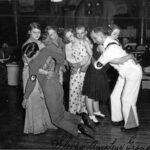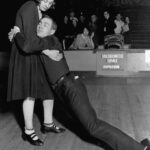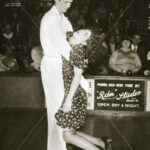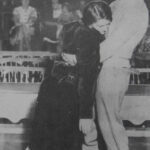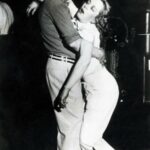Dance Marathons of the 1920′s and 1930′s
Y’know, I always used to think that the wild debauchery of the ‘Roaring Twenties’ was an exaggeration by conservatives threatened by women’s sexual liberation, but after reading about dance marathons, I’ve started having serious doubts:
Dance Marathons (also called Walkathons), an American phenomenon of the 1920s and 1930s, were human endurance contests in which couples danced almost non-stop for hundreds of hours (as long as a month or two), competing for prize money.
[…]
Contestants, who danced in pairs, were required to remain in motion (picking up one foot, then the other) 45 minutes each hour, around the clock. Dancing was often loosely interpreted to include shuffling along while shaving with a special mirror hung around the female partner’s neck, writing letters on a special folding desk hung around one’s own neck, reading the newspaper, knitting, or even sleeping as one’s partner supported one’s weight. The “carrier” in such a couple often tied the “lugging” partner’s wrists together with a handkerchief and hooked them around the carrier’s neck for additional security. […]In extreme cases, partners were fastened together with dog chains to prevent them from drifting apart.
[…]
Fifteen minutes each hour were allotted for rest. When the air horn signaling a rest period sounded, the contestants exited the dance floor for curtained-off rest areas filled with cots. These rest areas were segregated by sex. Contestants trained themselves to drop instantly into deep sleep as soon as their bodies touched the cots. After 11 minutes the air horn sounded again and the contestants filed back onto the dance floor to begin another hour. Female contestants who didn’t wake at the end of 11 minutes were revived with smelling salts (and slaps), and male contestants were often dunked in a tub of ice water.
[…]Most marathon promoters fed contestants 12 times a day – oatmeal, eggs, toast, oranges, milk, etc. Couples had to continue the shuffling dance motion while they ate the humble but filling meals. These meals were served at a chest-high table since the contestants ate standing up. Twelve meals a day during the Great Depression was a powerful inducement to many who joined endurance marathons.
[…]
Intense fatigue sometimes led contestants to “go squirrelly,” especially during the wee hours of the morning. “Fatigue brought them to a state resembling a coma, a state which seemed to offer relief from the soreness of the day’s travail. During these episodes, contestants hallucinated, became hysterical, had delusions of persecution … acted out daily rituals: they talked to an imaginary companion, grinned vacantly, and snatched objects from the air” (Calabria, p.77). For the audience, watching contestants go squirrelly offered a queasy thrill.
When attendance dropped, promoters began the final push of elimination events. “‘Grinds” were continuous dancing with no rest periods. A grind continued until one or more couple fell and was disqualified, literally ground down in exhaustion. During grinds, even the usual tricks dance partners used to keep each other on their feet (pin pricks, slaps, shaking, pinching, even conversation) were forbidden.
